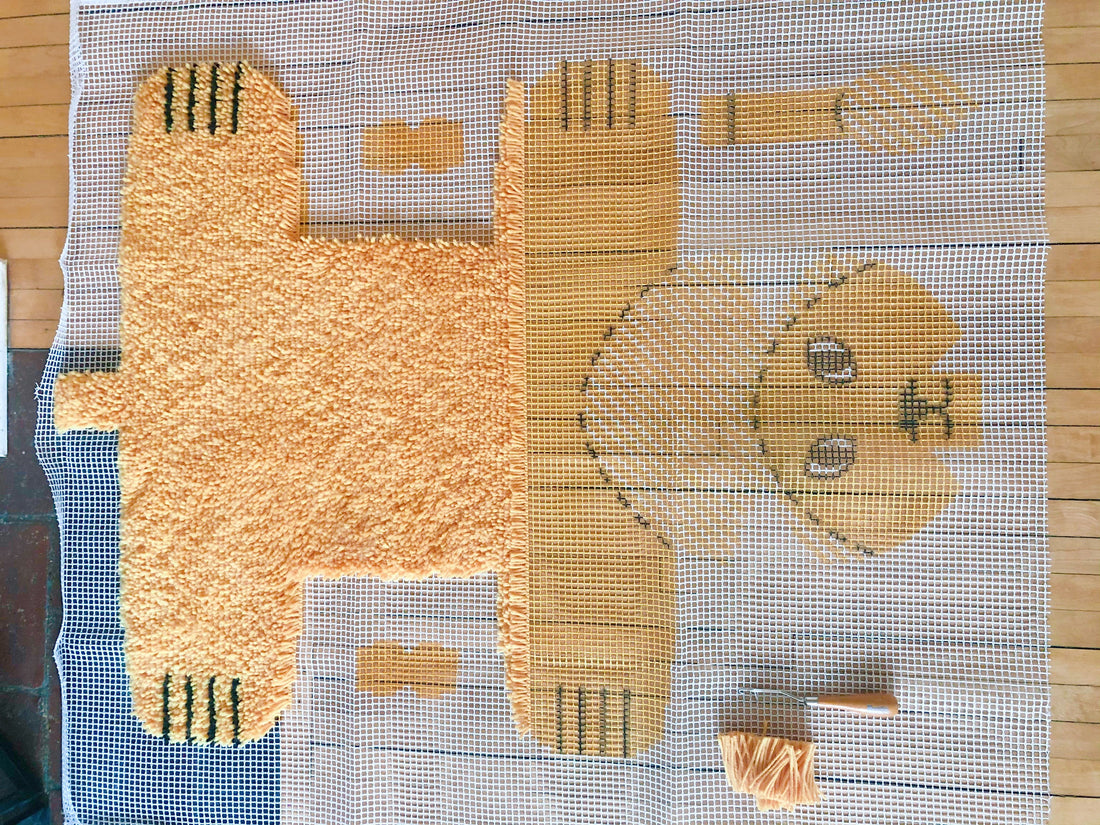
Latch Hook: Helpful Hints and Tips They Don't Tell You
Meg ☺
Latch hooking is a craft in which you attach short pieces of yarn to horizontal strands of a canvas grid. Although not limited to, latch hooking is known mostly to be used in the making of rugs, pillows, and wall-hangings. Because of its ease, latch hooking can be a very relaxing hobby for both children and adults.
Although latch hooking is a pretty easy craft form, there are a few hints and tips in the latch hooking process I wish I knew when first starting out. Knowing these simple, yet important tips will help ensure your very best finished product!
[TIP] 1. Before starting, familiarize yourself with the project kit in its entirety.
Spread out your canvas, define your colors* and read the instructions... all the way through. Determining what colors are (like which color is "Spice" versus the color "Cinnamon" and "Rust") beforehand ensures you won't put yourself in the situation of using the wrong color. Even if the colors are vastly different, just get into this habit. You'll thank me later!
[TIP] 2. The best way to hold your rug or article is the most comfortable way.
Bucilla states that the most experienced latch hookers prefer to sit at a table (one that is not too high) with the article spread out across the table, with one end or edge towards you. I've found this works well if your seating is about 6 inches lower than your table.
[TIP] 3. Use the color pattern key, illustration, and the kit's box art photo to make decisions.
When working on an article, have all three of these things either out in front of you or at least an arm's length away. I like to follow the illustration instructions mostly, but make adjustments as I see fit. For example, the lion's eyes on the kit's box art photo look a bit more round than they do on the printed canvas and illustration. I prefer the more rounded look, so when I get to the eyes, I might deviate the printed canvas to achieve this.
[TIP] 4. The print on the canvas almost always doesn't line up correctly.
Because of this, you'll have to either, 1. make a judgment call (when the article you are working on is NOT symmetrical) or 2. create symmetry by counting grid spaces and latching where appropriate. This could mean you are latching on a non-printed surface as well as leaving some print unlatched.
[TIP] 5. Use a counter-weight for large projects.
Because you work from the bottom left to upper right, as your work progresses, the canvas will start to become heavy and hang off the table. When this happens, you will notice your article starting to slip and you will need to use some sort of counter-weight in the upper right-hand corner of your article. I usually use my phone and whatever I'm drinking (although this probably isn't the smartest move). If I had one, I would probably use a cool resin paperweight. Really though, anything heavy enough will work.
[TIP] 6. Make corrections as you go.
If you make a mistake -- whether that be making the ends completely uneven where you cant fix it with a simple tug of either side or fraying / unwinding the yarn as you finish the latch -- fix it right away. Simply remove the yarn and replace it. Sometimes, a strand of yarn might be too long and you notice this after latching. Simply cut yarn even with the rest.
Check out our selection of diy kits here!



10 comments
Hey Mary!
Re: “When doing a printed canvas going by color only. What to do when the block has 2 colors and they look the same size. Which color do you use”
After checking the pattern key and still confused, examine the surrounding blocks. Often, the correct color will blend more naturally with the adjacent sections. Choose the color that best aligns with the overall flow of the design. Consider the design’s intention. Don’t be afraid to use your own judgement – its the overall look YOU want to achieve.
I find a lot of times, I don’t give myself “creative credit.” Think about it and trust yourself <3. I hope this helped a bit and your project turns out wonderful!
Hey Joanie!
Re: “I made my pillow yard too long. What’s the best way to cut it evenly?”
1. Finish the Latch Hooking: It’s best to complete the entire project before trimming, as it’s easier to see how the finished design looks.
2.Use Sharp Scissors: Once the project is done, use a pair of sharp scissors to carefully trim the yarn to the desired length.
3. Cut Gradually: Trim a little bit at a time to avoid cutting too much off. It’s better to make several small trims than to accidentally cut too short.
Take time with this process to achieve the best results <3! Hope this helps and happy crafting!
I made my pillow yard too long. What’s the best way to cut it evenly?
When doing a printed canvas going by color only. What to do when the block has 2 colors and they look the same size. Which color do you use
Hiya Chantelle!
re: Does it truly matter which strands of the canvas you hook on. In the directions on the one I just started it says to hook on the strands that only have one twist in them. Only thing is that I have already gotten 13 rows done hooking on the strands that are twisted multiple times. Should I take it out and start over?
I referenced the latch hooks I have done in the past and this does, sadly, seem to be the case (only latching on the horizontal, single-twisted strands). I’m sure there is some sort of reason for this, but I’m not quite sure why (potentially a durability thing). I usually stick to making corrections as I go, but ultimately it’s your decision. I would take things like what it’s for, time, effort, & materials into consideration.
Hope this helps! <3